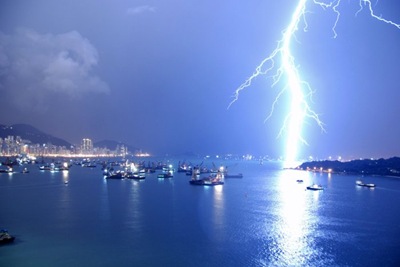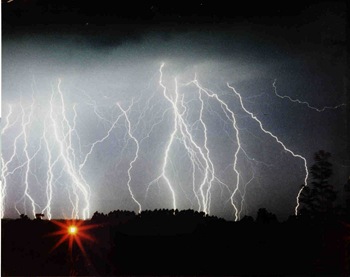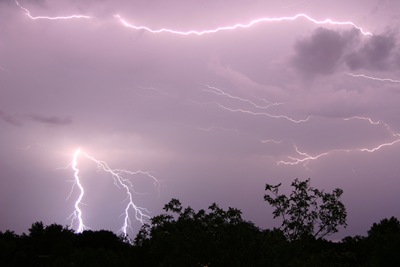Being one of the most unpredictable forces of nature, lightning storms present a unique challenge for most photographers.* We’ve all seen powerful photos of lightning in action and you may be wondering how you can capture the majesty of a storm the next time you’re fortunate (or unfortunate) enough to witness one.* While a lot matters on what Mother Nature decides to do with all that electricity, the tips below should help in capturing a great shot of lightning.
- Use a steady surface – While a tripod typically works best, in reality any steady surface will work.* Some people use a beanbag or other malleable item, like a pillow.* This will be import as #2 is….
- Long Shutter Times – While lightning is unpredictable, it’s extremely hard to make a decent capture by tripping the shutter when you see a flash.* There are some fancy remote controls that have the ability to trip when the flash is sensed, but I’m guessing you don’t want to invest in these types of gadgets.* Depending on your cameras ability to manage noise on slow shutter speeds, using a timing of 30 seconds can work well. The bulb setting can also be handy if you have a way to keep the shutter open.
- Horizon Up – It’s safe to say most of the lightning action you will see will in the sky.* I know it’s obvious, but it needs to be stated that your field of view will be skewed toward the sky then.* Depending on how close the lightning is, you’ll be including more blank looking sky than normal.* But fear not; that sky becomes far more exciting when the lightning starts
- But Include Something Interesting – While the action will be in the sky, don’t forget to keep something in the frame to give relevance and perspective to the shot.* Buildings are a favorite, but really, anything that can give an idea of the size of the storm works well.
- Manual Focus – It’s best to use manual focus when shooting in lightning situations.* Mainly because the view will probably be at night (but not always) with a fair amount of darkness.* Rather than allow your camera to hunt around for something to focus on with each new shot, get a good manual focus on the sky and leave it there.
- Manual Shutter/Aperture Too – As mentioned in #2, if your camera has the ability to set the shutter speed, pick a long shutter time and a fairly wide aperture.* The action will be far from you so a wide aperture and shallow depth of field won’t be a problem (unless you have some very near objects you’d like to include).
- Stack ‘em – If you can keep your camera in a steady spot, shot after shot, you can use stacking software to combine multiple strikes into one image. You’ll often have many unexciting shots with maybe just a single strike or faint action between clouds.* These can all be combined to make a spectacular image.
- Be Patient – This is a big one and a key to success.* Get familiar with your gear and settings so when there is a lightning storm you can set up the camera and then let it do its thing while you enjoy the show.* You’re going to have a number of times when you miss “the shot” for one reason or another.* Don’t sweat it.
Shooting lightning storms can be a very enjoyable experience but it takes a little practice to get it just right. Follow the steps above and you’ll be well on your way to creating electrifying photos (sorry, couldn’t resist the pun!).
Source











 Reply With Quote
Reply With Quote


Social Networking Bookmarks